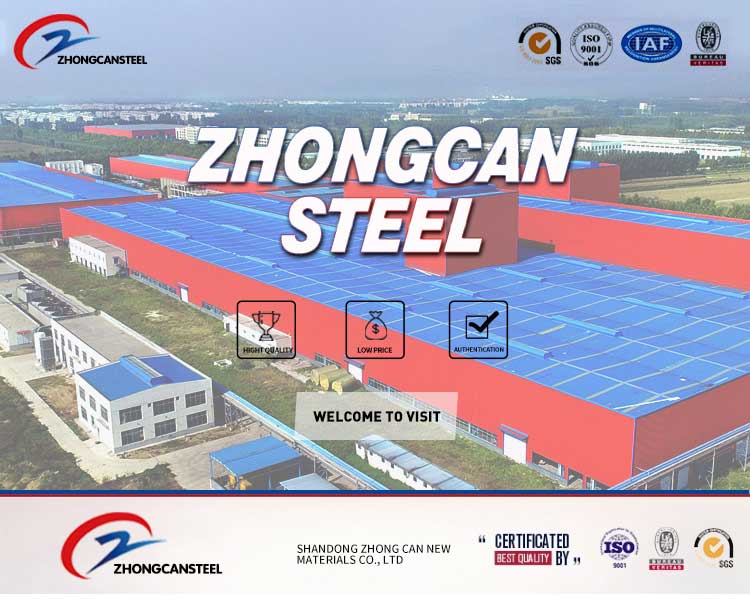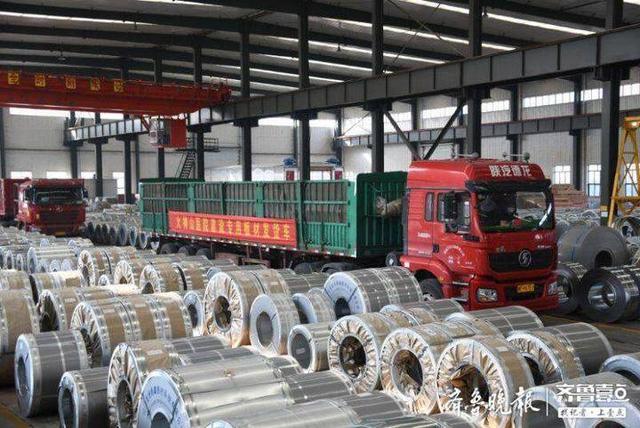版权所有 © 2018 山东中灿 ICP备案号:鲁ICP备16001552号-1 网站建设:中企动力 济南二分
ABOUT US
Tel: 0086-538-6315517
Fax: 0086-538-6315510
Phone:0086-15588577955
Adress:Hi-Tech Development Zone,
Feicheng,Taian,Shandong ,China.
E-mail:ella@zhongcansteel.com
PRODUCTS
websites
0086-538-6315517
Service Hotline
Analysis of atmosphere and dew point in continuous annealing of hot dip galvanizing
In order to reduce the surface iron oxide and no longer be oxidized, the strip steel needs to be in a reductive protective atmosphere. The protective gas available is hydrogen. Pure hydrogen has the strongest protection performance, but it is almost impossible in production. Therefore, the protective atmosphere used in industry is a nitrogen hydrogen mixed system, which is considered in safety. On the premise of ensuring its protective performance, the hydrogen content used is as low as possible [1].
Hydrogen has a strong reduction ability. At high temperature, it can capture oxygen from iron oxide and reduce it to pure iron. Moreover, the reduction ability of hydrogen increases significantly with the increase of temperature. Nitrogen is a neutral and inert gas, which is stable in nature, does not self ignite or support combustion, and is usually not combined with other elements. Nitrogen in the shielding gas actually plays a role in strengthening the vehicle for the reaction of hydrogen and oxides.
In the case of high absolute hydrogen content and low percentage content in the protective gas or low absolute hydrogen content and high percentage content in the protective gas, the hot-dip galvanized steel strip with satisfactory quality can be produced. This is because when the total amount of shielding gas is small, the nitrogen content is also small, but the hydrogen content is high, and hydrogen molecules still have more opportunities to move to the surface of the steel strip and react with iron oxide to achieve the purpose of iron oxide reduction. When the total amount of shielding gas is large, the content of hydrogen is low, but the content of nitrogen is high. The hydrogen molecules with low percentage still have more chances to be collided by nitrogen molecules into the steel strip and react with iron oxide to achieve reduction. In order to reduce the cost, we should choose the protection gas with small total amount and high hydrogen content.

2. Furnace atmosphere control
The difficulty of atmosphere control in zinc annealing furnace is mainly the control of non oxidizing atmosphere in NOF section, which directly affects the adhesion of zinc layer [3].
2.1 analysis of the reasons for the formation of no oxidation atmosphere in NOF section
(1) the heating value of the gas used in NOF is low and fluctuates greatly. The non oxidizing atmosphere is realized by adjusting the equivalence ratio of air and gas (i.e. the air excess coefficient). In NOF, the air excess coefficient is generally controlled at about 0.94, i.e. the gas is relatively excess. When the gas calorific value fluctuates too much, especially downward, the combustible components in the unit volume are reduced, and the required combustion air equivalent should also be reduced, and the control of combustion air flow is based on the gas flow control, which results in the relative excess of air and the generation of oxidizing atmosphere.
(2) NOF furnace temperature control is improper. When the oil film on the surface of steel strip is removed in NOF, the effect of combustion gas on the surface of steel strip mainly depends on the combustion temperature. From the oxidation-reduction equilibrium diagram of steel (see Figure 1), it can be seen that when the temperature of furnace gas is below 1150 ℃, the furnace is an oxidizing atmosphere, that is to ensure that the furnace is a reducing atmosphere, and the temperature at the furnace outlet must be above 1100 ℃ (that is, the temperature of furnace gas should be 120 Above 0 ℃, the furnace temperature is usually 100 ~ 150 ℃ lower than the furnace gas temperature).
(3) the proportion control system of NOF air and gas is out of order, the solenoid valve of switch air and gas is out of order, the control of air excess coefficient is difficult to maintain, and the furnace is in an oxidizing atmosphere.
(4) the NOF furnace mouth is not sealed tightly. Once the furnace pressure is reduced, air enters the furnace and destroys the atmosphere in the furnace.
2.2 improvement and Solutions
(1) the coke oven gas with fine desulfurization and high calorific value is selected as the fuel, and the fluctuation range of calorific value is controlled within ± 5%.
(2) advanced furnace temperature detection and control system shall be adopted. Continuous combustion shall be controlled by zones. Furnace temperature of each section shall be controlled and measured separately. Fuel and combustion air quantity of each zone shall be controlled separately to make air-fuel ratio fixed.
(3) check the solenoid valve of air gas switch regularly. When a solenoid valve fails, there should be a red alarm display on the HMI of central operation room.
(4) sealing equipment is set at the entrance of preheating section, and the position of sealing door is manually adjustable, and sealing gas is continuously supplied; pressure control baffle is installed at the upstream of exhaust gas fan to control the pressure of preheating section; meanwhile, burner load condition is used to control the speed of exhaust gas fan to improve the controllability of furnace pressure; furnace pressure sensor is installed at the entrance of pH / NOF section, Monitor the furnace pressure in real time.
3. Dew point
Dew point is the air temperature when water vapor in the air is saturated. The dew point of atmosphere in annealing furnace is the sign of water content in the protective gas in the furnace. The dew point can affect the reduction of iron oxide on the surface of steel strip. Through the measurement and analysis of the dew point in the furnace, the change of the composition of the protective gas in the furnace and the reduction state of the steel strip surface by hydrogen can be inferred indirectly.
Hydrogen in the protective gas reduces iron oxide to form water, and the dew point of the protective gas gradually increases. The protective gas is against the running direction of the steel strip, so the dew point of the protective gas is increasing from the inlet of the protective gas at the end of the cooling section to the inlet of the steel strip of the annealing furnace, as shown in Figure 2.
When the iron oxide on the steel strip surface is reduced by hydrogen in the reduction furnace, the dew point temperature should not be the controlling factor for the reduction reaction. At a certain temperature, as long as the supply of hydrogen is sufficient, that is, the partial pressure of hydrogen is greater than that of water vapor, the reduction reaction of steel strip can be carried out thoroughly [2], that is, in production, as long as the equilibrium curve is met, the reduction reaction can be carried out thoroughly, and good adhesion of zinc coating can be obtained.

4. Effect of atmosphere and dew point on selective oxidation
In general industry, the annealing atmosphere is N2 + 5% H2, and the dew point is - 30 ℃, which is called galvanizing atmosphere. In this atmosphere, iron oxide scale can be reduced, but the oxidation of alloy elements can not be prevented, because there is a small amount of water vapor and oxygen in the atmosphere, which is selective oxidation [3,4].
Annealing atmosphere is the most important factor affecting the morphology of selective oxide particles. The shielding gas in the recrystallization annealing furnace on the continuous hot-dip galvanizing line is generally pure N2 atmosphere and mixed N2 + H2 atmosphere. No matter what kind of shielding gas is used, the surface oxidation of alloy elements inside the strip is inevitable. However, the oxidation experiments on the surface of most of the strip steel show that in the pure N2 atmosphere, it is very easy to form the manganese rich oxide particles with edges and corners on the surface of the strip steel, while in the N2 + 10%H2 atmosphere, it is easy to form the flat silicon rich oxide particles. This means that the annealing atmosphere seriously affects the chemical composition and atomic structure of the selective oxide during the annealing process [5].
In the process of hot-dip galvanizing of strip steel, dew point is one of the important factors that affect the selective oxidation of alloy elements on the surface of strip steel and the galvanizing performance of strip steel. With the change of dew point, the shape and composition of the selective oxides of alloy elements on the surface of strip steel also change, and the oxide composition of different steel grades is different. With the increase of dew point temperature, the diffusion ability of oxygen or oxidizing elements increases, and the depth of internal oxide layer increases. With the increase of dew point, the partial pressure of oxygen increases gradually, and the oxidizability in atmosphere also increases. When the oxidizability is strong enough, the contribution of oxygen diffusion to the strip steel is greater than that of alloy element diffusion, which leads to the problem of external oxidation to internal oxidation. Therefore, the surface oxidation of alloy elements changes into internal oxidation, the content of oxide on the surface of alloy elements decreases, and the internal oxide layer thickens, thus improving the galvanizing performance of steel strip [5].
It is found that if the partial pressure of water vapor is high enough, increasing the hydrogen content in the annealing atmosphere will not work; increasing the hydrogen content will increase the dew point of the oxide that begins to precipitate; if the dew point is a certain value, increasing the hydrogen content can avoid the formation of some oxides. Cvijovic I et al. [7] found that when the content of H2 increased, the partial pressure of oxygen decreased, so the surface oxide was less. At the same time, the permeability of oxygen decreases and changes into internal oxidation. According to Lamberigts M[8], selective oxidation is usually the main phenomenon under the protective atmosphere with certain dew point. With the increase of dew point, oxidation develops from surface to interior.
There are many and complex factors affecting the selective oxidation of alloy elements, and some of them are interrelated. Therefore, in the study of various factors, it is not allowed to consider the influence of a single factor on the selective oxidation of alloy elements, so the conclusion may be inaccurate or even wrong. Only by considering the influence of all factors on the selective oxidation of alloy elements, can better adhesion and galvanizing performance be obtained.





